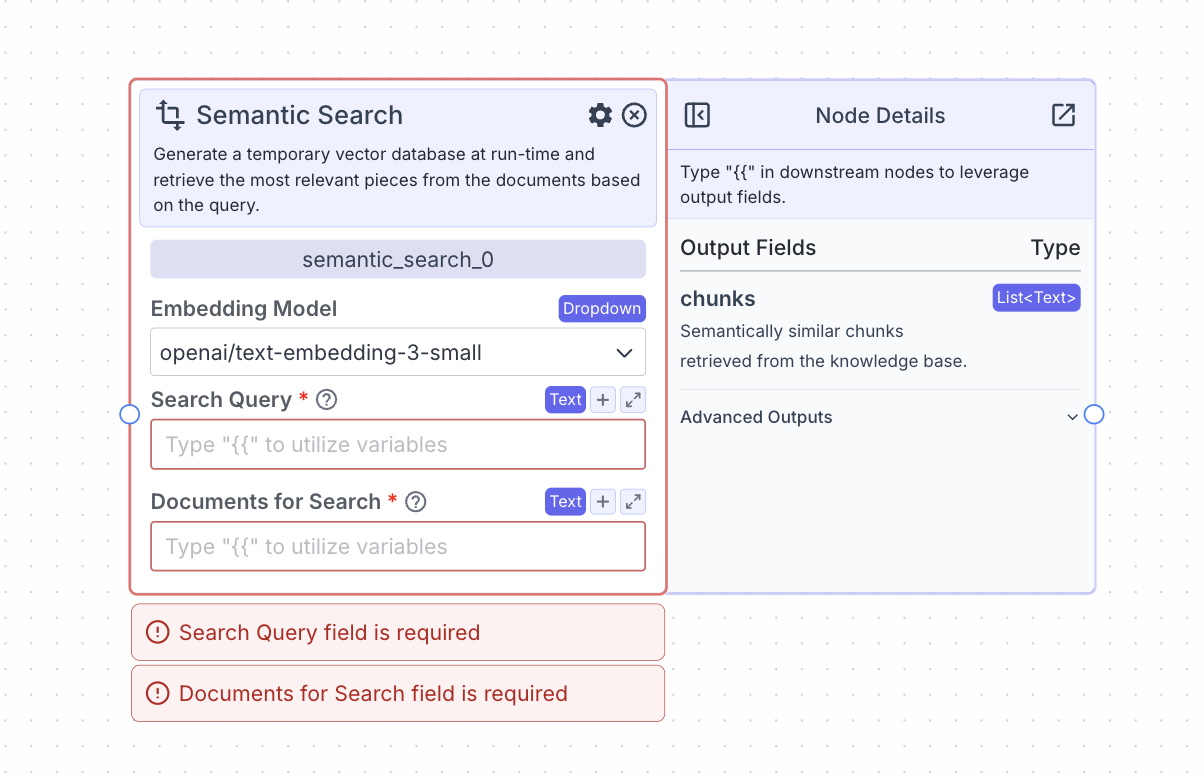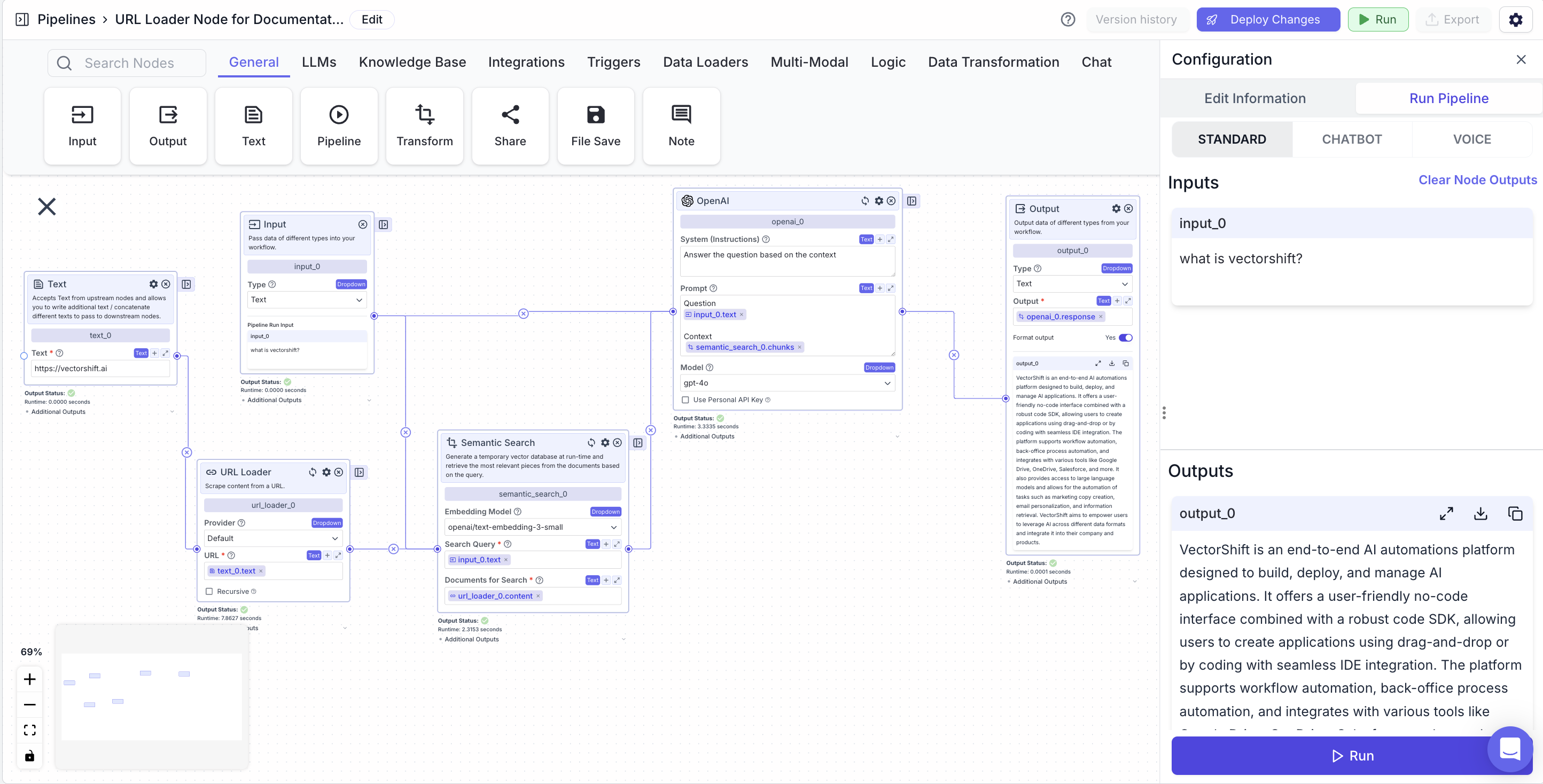Skip to main content The semantic search nodes embeds and queries documents semantically at run time.
In contrast to the knowledge base, which is a permanent store of data, documents embedded using the semantic search node are immediately deleted after the pipeline finishes running.
The semantic search nodes embeds and queries documents semantically at run time.
In contrast to the knowledge base, which is a permanent store of data, documents embedded using the semantic search node are immediately deleted after the pipeline finishes running.
- Search Query: The query that will be used to search the embedded documents semantically for relevant pieces
- Documents for Search: The text that will be semantically searched
Node Parameters
On the face of the node:
- Embedding model: The embedding model to use to embed the documents
In the gear:
- Max chunks per query: the maximum number of pieces of data to be returned per query
- Enable Filter: enable the ability to write a metadata filter
- Enable Context: enable a text field to provide additional context for the search query
- Re-rank documents: Performs an additional reranking step to reorder the documents by relevance to the query
- Score Cutoff: The minimum relevancy score (between 0 and 1) that each piece of data will have semantically to the query
- Retrieval Unit: Return the most relevant chunks (text content) or Documents (will return document metadata)
- Transform Query: Transform the query for better results
- Answer Multiple Questions: Extract separate questions from the query and retrieve content separately for each question to improve search performance
- Expand Query: Expand query to improve semantic search
- Do Advanced QA: Use additional LLM calls to analyze each document to improve answer correctness
- Show Immediate Steps: Display the process the knowledge base is conducting at a given time in the chatUI
- Format Context for an LLM: Do an additional LLM call to format output
Node Outputs
If Retrieval Unit is set to Chunks
- Chunks: Semantically similar chunks retrieved from the documents
- Type:
List<Text>
- Example usage:
{{semantic_search_0.chunks}}
If Retrieval Unit is set to Documents
- Documents: Metadata for semantically similar documents retrieved from the documents
- Type:
List<Text>
- Example usage:
{{semantic_search_0.documents}}
If “Do Advanced QA” is enabled
- Response: A direct answer to the query
- Type:
Text
- Example usage:
{{semantic_search_0.response}}
Considerations
- Use a semantic search node when your pipeline loads new data at run time for querying. Use a Knowledge Base Reader node when you want to query previously loaded data that has already been loaded.
- If the semantic search node is not returning relevant information to a query, try increasing the number of max chunks per query in the gear of the knowledge base.
- For debugging purposes, you may attach an output node to the semantic search node to view the chunks that are returned for the query.
Example
The below example is a pipeline which answers questions about on the contents of a website (example is with VectorShift’s website).
- Input Node: The query about the website.
- Text Node: The URL for the website.
- Scrape URL node: Scrape the website URL
- Semantic Search Node: Find semantically similar chunks to a question (input node) based on a website (Scrape URL node).
- Search Query:
{{input_0.text}}
- Documents for Search:
{{url_loader_0.content}}
- LLM Node: Answer a user query (input node) based on relevant information (semantic search node).
- Prompt:
{{input_0.text}} and {{semantic_search_0.chunks}}
- Output Node: Display the LLM’s response.
- Output:
{{openai_0.response}}

 The semantic search nodes embeds and queries documents semantically at run time.
In contrast to the knowledge base, which is a permanent store of data, documents embedded using the semantic search node are immediately deleted after the pipeline finishes running.
The semantic search nodes embeds and queries documents semantically at run time.
In contrast to the knowledge base, which is a permanent store of data, documents embedded using the semantic search node are immediately deleted after the pipeline finishes running.

